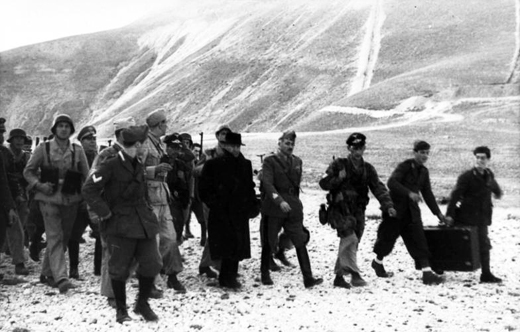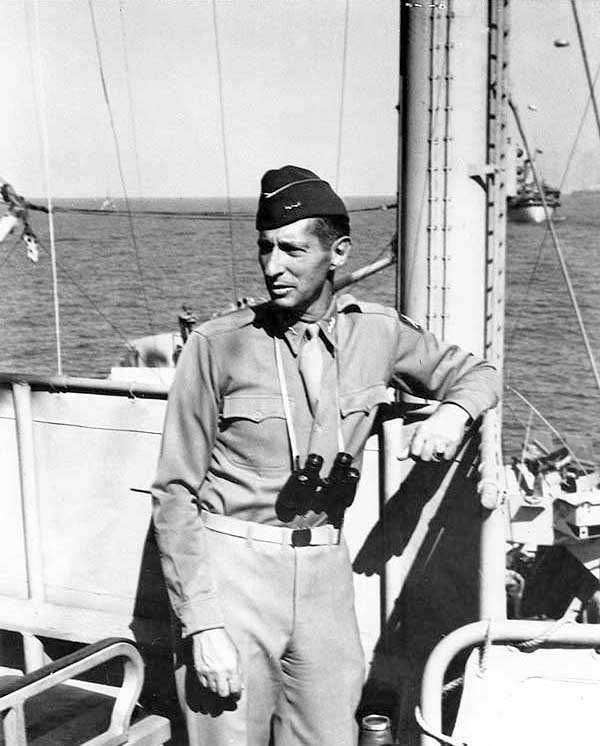Air Operations, Bismarcks
- V Bomber Command B-25s attack barges at Cape Gloucester.
- 3rd Light Bomb Group A-20s attack a radio station at Gasmata.
Air Operations, CBI
CHINA- 8 449th Fighter Squadron P-38s attack shipping at Hong Kong. 4 P-38s attack Yangtze River shipping. 4 23rd Fighter Group P-40s attack barracks and a locomotive near Shihhweiyao.
Air Operations, Europe
US 12th AIR FORCEGREECE:
IX Bomber Command B-24s attack Kalathos and Maritsa Airdromes.
ITALY:- XII Bomber Command B-17s attack road defiles at Mignano, a road bridge at Benevento, and the Frosinone Airdrome.
- NATAF aircraft provide support for Allied forces in the beachhead throughout the day, and attack numerous communications targets in the area.
- In fighter action, 82nd Fighter Group P-38s down 2 Luftwaffe fighters over the sea near Salerno during the afternoon.
- During the night, NATAF aircraft fly numerous intruder missions over six Axis airfields between Rome and Pizzo.
Air Operations, New Guinea
- V Bomber Command B-17s and B-24s attack Lae and B-25s strafe coastal targets between Langemak Bay and Saidor.
- Australian Army ground forces occupy Salamaua and the airfield at Salamaua, which is immediately put to use by a 5th Air Force combat airplane.
Air Operations, Solomons
During the night, 394th Heavy Bomb Squadron radar-equipped SB-24s attack several ships in the northern Solomons.
[Eastern Front
The Soviet attacks continue in all sectors but with renewed vigor near Bryansk. On the Donets front Stary Kermenchik is taken. The Germans begin to evacuate 17th Army from the Kuban. Altogether 239,669 troops, 16,311 wounded, 27,456 civilians, 74,657 horses, 6,255 head of cattle, and vast amounts of army supplies and vehicles are withdrawn by October 9.
[Germany, Home Front
The 'Solf tea-party' resistance group, mostly German diplomats, is broken up by the Gestapo.
[Italy
In the US 5th Army area, a critical period begins as the enemy renews strong efforts to reduce the beachhead. The airstrip is completed in the Paestrum area. Capri, in the Gulf of Naples, is occupied by Allied forces. In the VI Corps area, the German counterattack, recovering Hill 424 and Altavilla from the 142nd Infantry, 36th Division. The situation of the 45th Division on the northern flank of the VI Corps improves. The 179th Infantry occupies Persano while the 157th, after a seesaw battle, seizes the tobacco factory barring its advance in the region west of the Sele. The 36th Combat Engineers takes up positions on the left flank of the 157th Infantry. The Corps begins regrouping after nightfall to strengthen its exposed left flank. The 179th Infantry moves from the Sele-Calore corridor, which the 2nd Battalion of the 143rd Infantry comes north to defend, to the left flank of the 157th Infantry.
8th Army takes Crotone and continues its advance. At Salerno the first major German counterattacks begin late in the day. The British are driven out of Battipaglia once more and in Molina Pass the unit which has replaced the Commandos is under heavy pressure from part of the Hermann Göring Pzr Division. The 167th Brigade, 56th Division, suffers heavy casualties in this action and is relieved by the 201st Guards Brigade. The US Ranger force on the left flank of the X Corps withstands enemy attacks.
|
|
Mussolini is rescued from the Hotel Camp Imperatore in the Abruzzi Mountains in a daring action by 90 German glider-borne parachute troops led by Otto Skorzeny. The 250-man Italian force guarding Mussolini surrender within minutes. He is taken to Germany. The Germans have been trying to organize such an operation since Mussolini was arrested but he has never been kept for long in one place. The operation even now is technically very difficult and is executed with great daring. However, because of the success of the operation, the Germans begin to plan to kidnap Tito and Pétain.
Rescue of Mussolini |
 |
All the representatives of the Italian Government have already left Rome.
[Mediterranean
- U-boats commence operations off the Salerno bridgeheads. Only 3 ships will be sunk during numerous attacks.
- U-617 is attack by Wellingtons 'P' and 'J' of No 179 Squadron, having been detected by radar and then illuminated by Leigh Light. 'P' is the first to spot the U-boat and drops six depth charges. 3 hours later 'J' finishes the U-boat dropping six more depth charges. The U-boat did not sink but was lying on her side when spotted at daybreak having been abandoned by her crew. She was finally sunk by British destoyers.
| Class | Type VIIC |
| CO | Kapitänleutnant Albrecht Brandi |
| Location | N African coast, near Melilla |
| Cause | Air attack, beaching, scuttling |
| Casualties | None |
| Survivors | 49 |
New Guinea
The Australian 9th and 7th Divs adavance on Lae, from east and west. Salamaua, both the town and the airfield, is taken by troops from the Australian 5th Div. Farther north the Japanese at Lae are beginning to be hemmed in.
[Pacific
The US tug Navajo (AT-64), towing gasoline barge YOG-42, is sunk by Japanese submarine I-39, 150 miles east of Espiritu Santo.
[
